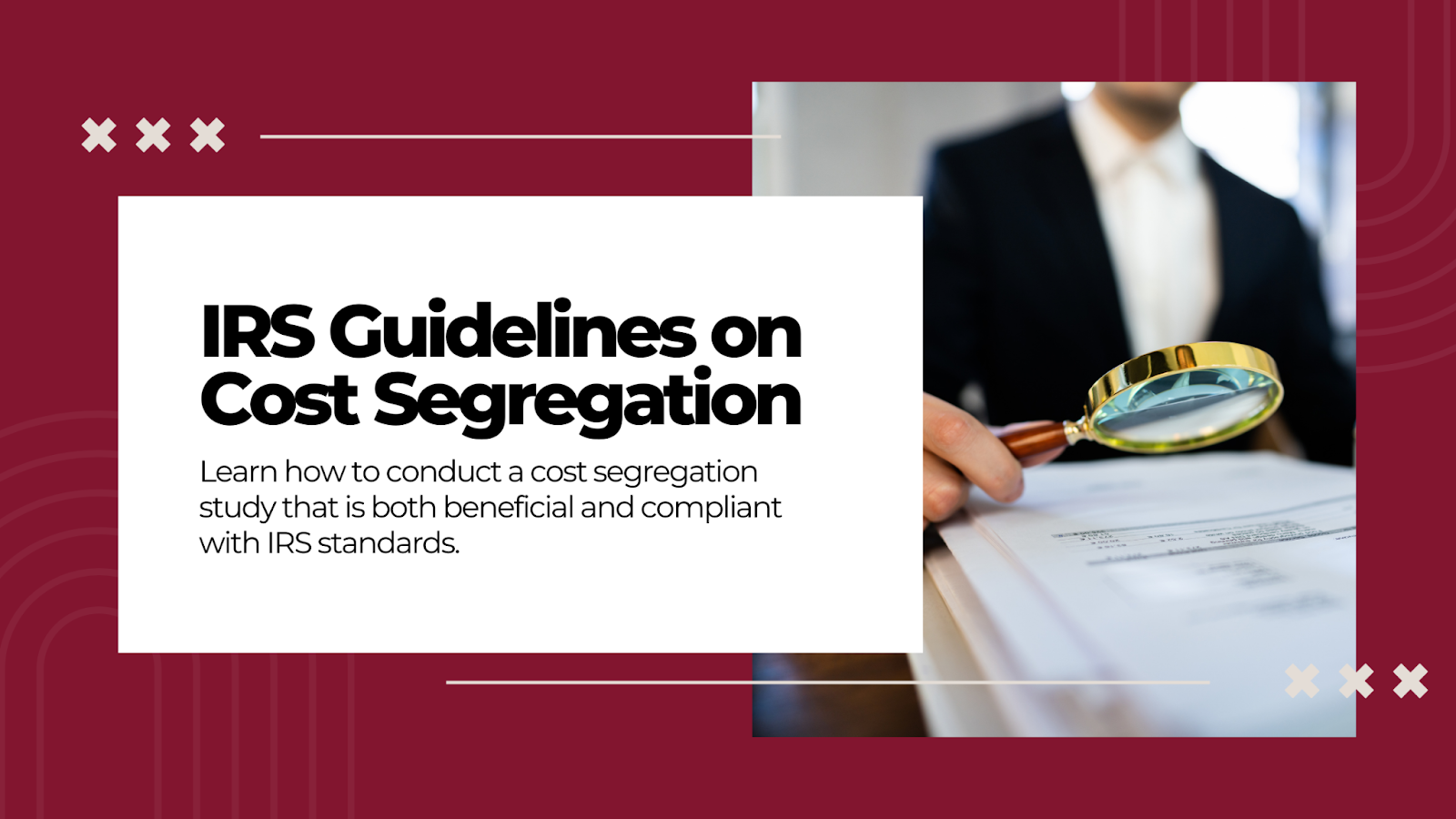Cost Segregation for Commercial Real Estate

Are you maximizing the financial potential of your commercial real estate investments? Many owners overlook a crucial strategy that could dramatically enhance their property's profitability. In the field of commercial real estate, cost segregation stands out as a powerful yet often underutilized tool. This approach not only sharpens your competitive edge but also unlocks substantial tax savings and improves cash flow.
This blog discusses the unique advantages and special considerations of cost segregation for commercial property owners. From small retail spaces to large office complexes, understanding how to strategically apply this method can transform your financial outcomes and set you on a path to greater success.
Understanding Cost Segregation in Commercial Real Estate
Cost segregation is a tax planning strategy specifically tailored for commercial real estate that involves identifying and reclassifying certain property components to accelerate depreciation deductions. In the context of commercial properties, this process allows owners to segregate building costs into shorter asset life classes, such as personal property or land improvements, rather than depreciating everything over the standard 27.5 or 39 years.
Why It Matters
Cost segregation holds particular significance for commercial property owners due to several key factors:
- Tax Savings: Commercial properties often involve substantial investments in building construction or improvements. By accelerating depreciation on certain components, owners can unlock significant tax savings in the early years of ownership, enhancing cash flow and overall profitability.
- Cash Flow Improvement: In the competitive landscape of commercial real estate, cash flow is paramount. Cost segregation allows owners to free up cash flow by reducing tax liabilities, providing more resources for property operations, renovations, or further investments.
- Strategic Asset Management: Commercial properties typically have a shorter holding period compared to residential properties. Cost segregation aligns with this shorter investment horizon by front-loading depreciation deductions, maximizing tax benefits during the ownership period.
- Enhanced Return on Investment: By optimizing tax savings and cash flow, cost segregation enhances the overall return on investment (ROI) for commercial properties. This can attract investors, improve property valuation, and strengthen the property's long-term financial performance.
Cost segregation empowers commercial property owners to leverage their assets more effectively, providing a competitive edge in the market and positioning them for greater financial success.
Special Considerations for Commercial Properties
Complexity of Commercial Properties
Commercial properties often feature intricate building structures and diverse asset classes, making cost segregation studies more complex compared to residential properties. The intricate nature of commercial real estate may involve multiple tenants, diverse lease arrangements, specialized building systems, and unique architectural features. These complexities require a comprehensive understanding and careful analysis to accurately identify and categorize assets for cost segregation purposes.
Furthermore, commercial properties may undergo renovations, expansions, or tenant improvements over time, adding layers of complexity to the cost segregation process. Proper documentation and coordination with all stakeholders are essential to ensure the accuracy and effectiveness of the study.
Types of Commercial Properties
Cost segregation can be applied to various types of commercial properties, each with its own set of considerations and opportunities:
- Retail Spaces: Retail properties often contain a mix of building components, including interior finishes, fixtures, and specialized lighting systems. Cost segregation can help identify and depreciate these assets separately, maximizing tax benefits.
- Office Buildings: Office properties may feature extensive interior improvements, such as partitions, cabinetry, and specialized equipment. By segregating these components, owners can accelerate depreciation and improve cash flow.
- Warehouses: Warehouses typically contain significant amounts of personal property assets, such as shelving, racking systems, and specialized machinery. Cost segregation can identify these assets for accelerated depreciation, leading to substantial tax savings.
- Mixed-Use Developments: Mixed-use properties combine various commercial components, such as retail, office, and residential spaces, within a single development. Cost segregation studies for mixed-use properties require careful consideration of each component's classification and depreciation schedule to optimize tax benefits.
Examples of Cost Segregation in Action
- Retail Space: A retail property undergoes a cost segregation study, identifying specific assets such as signage, display racks, and HVAC systems. By depreciating these assets over shorter periods, the property owner realizes significant tax savings.
- Office Building: An office building renovation includes upgrades to lighting fixtures, carpeting, and telecommunications infrastructure. Cost segregation allows the owner to segregate these assets for accelerated depreciation, improving cash flow and ROI.
- Warehouse: A warehouse expansion project includes the installation of specialized equipment and conveyor systems. Cost segregation identifies these assets for accelerated depreciation, providing immediate tax benefits to the property owner.
Benefits of Cost Segregation for Commercial Real Estate
Cost segregation offers several key benefits for commercial property owners, including substantial tax savings, improved cash flow, and enhanced return on investment (ROI).
Tax Savings
Cost segregation enables commercial property owners to accelerate depreciation on certain building components, resulting in immediate tax savings. By categorizing assets into shorter recovery periods, such as 5, 7, or 15 years, rather than the standard 27.5 or 39 years, owners can deduct a larger portion of their property's cost each year, reducing taxable income and lowering overall tax liabilities. This front-loading of depreciation can lead to significant tax savings, enhancing the property's after-tax cash flow and overall profitability.
Cash Flow Improvement
Front-loading depreciation through cost segregation can free up cash flow, which is essential for commercial property operations and further investments. By accelerating depreciation deductions in the early years of ownership, owners can access more capital to cover operating expenses, fund property improvements, or pursue additional investment opportunities. Improved cash flow enhances the property's financial flexibility and resilience, allowing owners to respond effectively to market changes and maximize returns on their investments.
Key Takeaways
Cost segregation stands out as a powerful tool that offers commercial property owners substantial tax savings, improved cash flow, and enhanced return on investment.
- Tax Savings: Cost segregation allows owners to accelerate depreciation on certain building components, resulting in immediate tax savings and reduced overall tax liabilities.
- Cash Flow Improvement: By front-loading depreciation, owners can free up cash flow, providing financial flexibility for property operations and further investments.
- Special Considerations: Commercial properties present unique challenges and opportunities for cost segregation studies, requiring thorough analysis and documentation to ensure accuracy and effectiveness.
Connect with Experts
The American Society of Cost Segregation Professionals (ASCSP) offers a network of qualified professionals who specialize in these studies. ASCSP members adhere to a high standard of practice and are equipped with the latest insights and methodologies in cost segregation.
We encourage you to reach out to a member of the ASCSP to discuss how a cost segregation study can benefit your specific property scenario. Whether you are new to property investment or looking to optimize your current assets, cost segregation professionals can provide the expertise you need to make informed decisions and achieve substantial financial gains!



